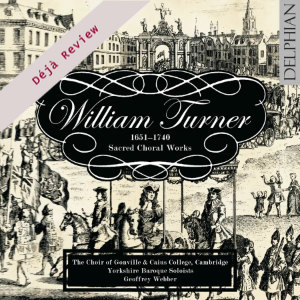
Déjà Review: this review was first published in July 2007 and the recording is still available.
William Turner (1651-1740)
Sacred Choral Music
Julia Doyle (soprano); William Purefroy, William Towers (alto); Paul Thompson (tenor); Daniel Jordan (bass)
Choir of Gonville & Caius College, Cambridge
Yorkshire Baroque Soloists/Geoffrey Webber
rec. 2006, Pembroke College Chapel, Cambridge, UK
Delphian DCD34028 [66]
William Turner in common with many composers in English music history is largely neglected because of the greatness of his contemporary. In Turner’s case the eclipsing contemporary was Henry Purcell (1659–1695). He was one of the composers who was active at the time of the Restoration, which began in 1660 after Oliver Cromwell’s Commonwealth. During this period church music was banned from English cathedrals. A restoration in music was needed, just like the political restoration of the monarchy.
Turner started his career as a treble in Christ Church in Oxford, but moved to London to sing in Westminster Abbey, together with John Blow and Pelham Humfrey. After his voice broke he became Master of the Choristers at Lincoln Cathedral. In 1672 he returned to London, where he was active as composer and singer. As an alto he sang on the stage as well as in church, in particular St Paul’s Cathedral (1683-1699) and Westminster Abbey again (from 1699). Although he grew very old most of his oeuvre dates from before 1700.
According to Geoffrey Webber there are several reasons why his musical output has never become standard church repertoire. No collected edition of Turner’s music is available. In addition, Turner’s anthems “contain comparatively little writing for trebles, and include almost no ‘full anthems’, i.e. settings predominantly for full choir. (…) Moreover, as with many other London verse anthems of the period, the sometimes long and taxing solo parts for the lower voices (counter-tenor downwards) may have been better suited to Turner and his London colleagues than the provincial lay-clerks of the period. … This recording presents a cross-section of Turner’s sacred music, ranging from small-scale liturgical works to one of his grandest creations, the Te Deum and Jubilate in D, and is the fruit of an editorial collaboration with Peter Seymour (University of York) and Bryan White (University of Leeds).” This collaboration has resulted in a very interesting disc which gives additional insight into the musical world of the Restoration in England.
The Te Deum and Jubilate are part of the Morning Service in D, which dates from 1696, and was written for the annual celebrations of St Cecilia’s Day in London. In the previous years the settings had been written by Henry Purcell (1694) and John Blow (1695). The Service can be interpreted as a musical tribute to Henry Purcell, as his influence is audible in several instances and Turner apparently deliberately refers to the setting by Purcell of two years before. The scoring is also comparable, with two trumpets, strings and bc. The solo parts are sung by members of the choir and by the additional soloists mentioned in the track-list. On the whole – here and in the other pieces on this disc – the voices from the choir do blend better than the soloists from outside the choir. In particular in sections from the Te Deum they use a bit too much vibrato and tend to overdo things a little. The performance as such is good, though, and there are many places where Turner shows his talent for expressing words in music. “O Lord, save thy people” is especially fine in this respect.
All other pieces are with basso continuo only – with the exception of ‘The Queen shall rejoice’, which was written for the coronation of Queen Anne in 1702, and which is for choir a cappella. It is a sign of Turner’s reputation that he also was asked to write two anthems for the coronation of James II in 1685, which unfortunately are lost. Interesting also is the anthem ‘The Lord is righteous’, dating from around 1700, which has an obbligato part for the organ, perhaps featuring the new organ which Bernard Smith had built for St Paul’s.
Turner’s works as recorded on this disc show his versatility and his individual dealing with harmony. In several places it is used to highlight specific elements in the text, like in “he hath scattered the proud in the imagination of their hearts” from the Magnificat. He also uses the false relations which are so typical of English church music of the 17th century.
Although I prefer performances of this kind of repertoire by all-male cathedral or college choirs I am very positive about this recording. The Choir of Gonville and Caius College is a fine choir, which is technically reliable and sings with flair and enthusiasm. The Yorkshire Baroque Solists give excellent support and Thomas Hewitt Jones realises the obbligato organ part in ‘The Lord is righteous’ very well.
All in all I recommend this disc without hesitation. Considering the lack of recordings of Turner’s oeuvre this recording is very important, and the quality of the music justifies the efforts of everyone involved. I sincerely hope more of Turner’s music shall be recorded – and performed live! – in the future.
Johan van Veen
www.musica-dei-donum.org
twitter.com/johanvanveen
If you purchase this recording using a link below, it generates revenue for MWI and helps us maintain free access to the site


Contents
Service in D:
Te Deum
Lord, thou hast been our refuge
My soul truly waiteth
Hear my prayer, O Lord
The Queen shall rejoice (1702)
Service in E:
Jubilate Deo
Service in A:
Magnificat
Nunc dimittis
O Lord, God of hosts, hear my prayer
The Lord is righteous
Service in D:
Jubilate Deo (1696)

















